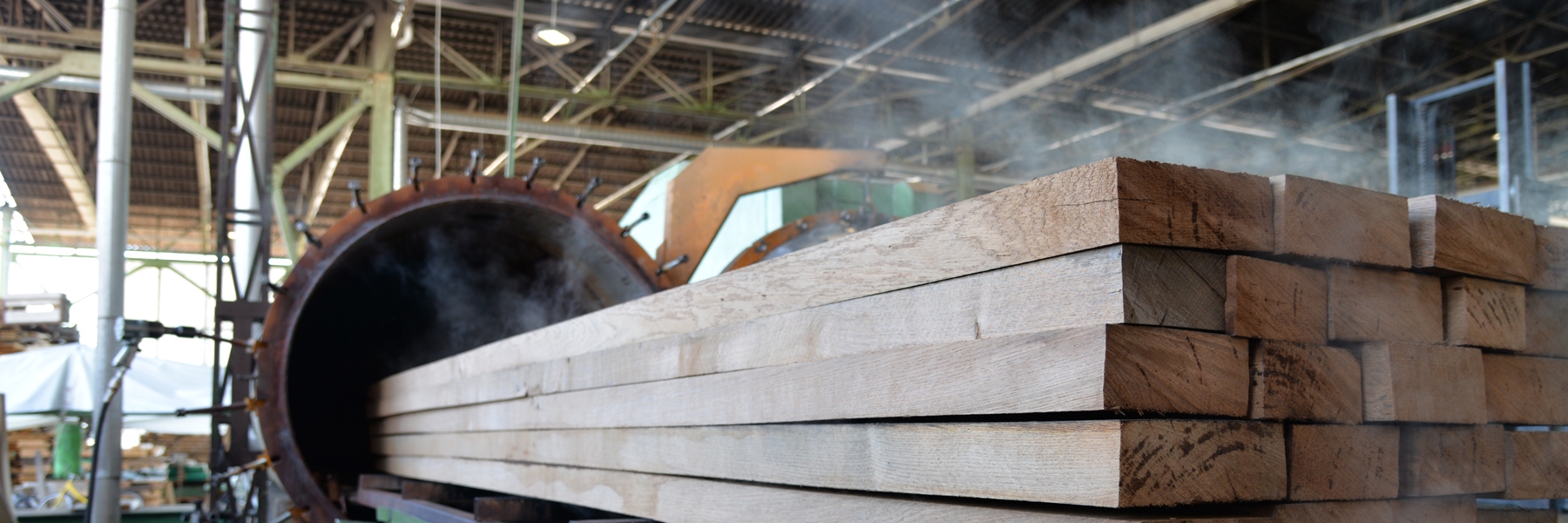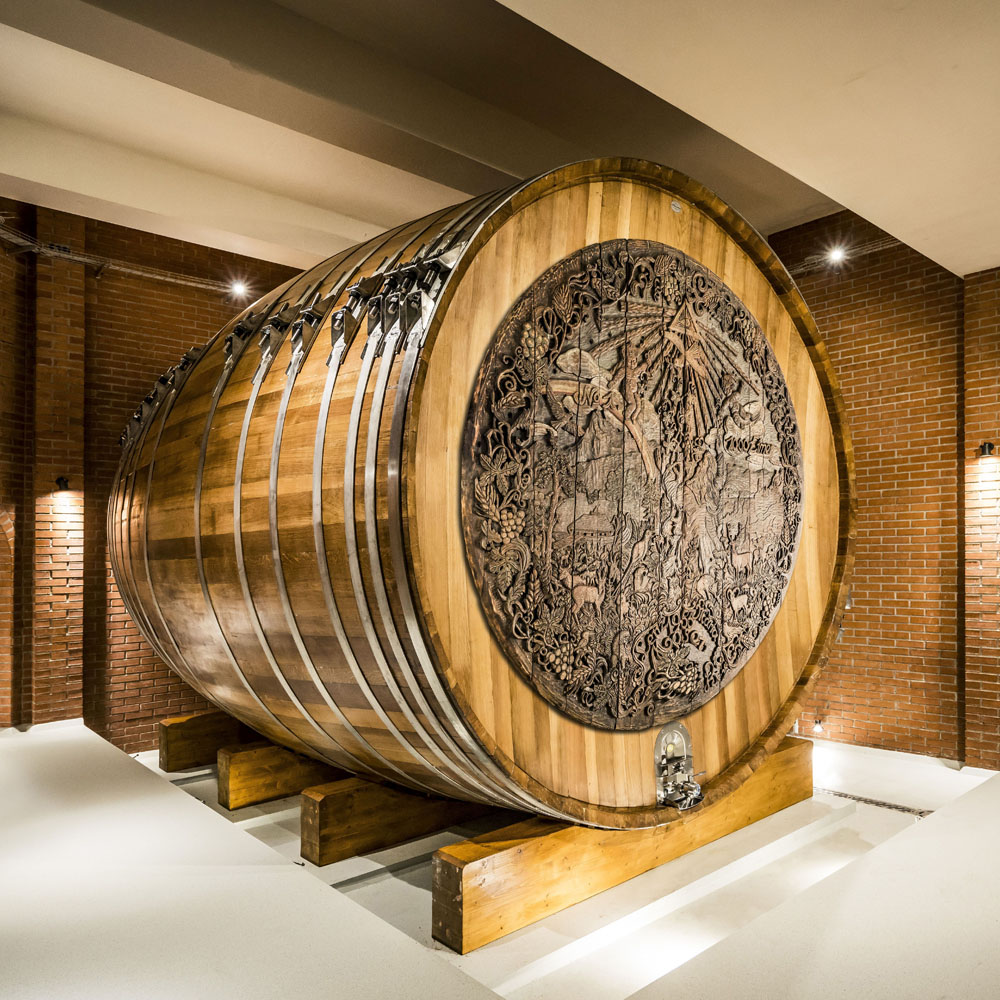
1.000-bucket vat
There was a lot of careful preparation behind this step at Lenz Moser: the first episode of an epochal event took place at the end of June 2017 when the new 1,000-bucket vat was set up.
A historic 1,000-bucket vat, the bottom of which was decorated with intricate carvings, had slumbered in the Lenz Moser wine vault for many decades. This 56,589 litre jewel had been used as an ageing tun for wine, but these days were long gone. Nevertheless, the vat increasingly became a source of inspiration for our head winemaker Ernest Grossauer (from 1986 to 2018) during his daily work. How to breathe new life into this gem? Wooden vats as such – in the form of barriques and barrels with a capacity of a few thousand litres – had always been held in high esteem at Lenz Moser. The decision thus slowly matured to restore the 1,000-bucket vat to its former glory. The vat itself was to be refurbished and its ornately carved bottom would continue to delight visitors.
Weight: around 13,000 kilograms
Number of staves: 108
Length of the staves: at the start of work approx 5.2 metres an after processing 4.9 metres
Stave thickness: 8.5 centimetres
Average width of a stave: 14 centimetres
Thickness of the bottum: 10 centimetes
Diameter at the widest point: 4.65 metres
Vat circumference at the widest point: 14.6 metres
Cooper wanted!
The search for a cooperage with both the necessary know-how and spatial conditions proved to be much more complicated. For example, the staves for a small wooden barrel only have to be bent once, but for the 1,000-bucket vat they have to be bent four to six times. This requires careful coordination, calling for a great deal of work and skill. What’s more, it has to be guaranteed that the wood will withstand the pressure of such a large amount of wine. This is why the bottom of the vat requires a double curvature (barrage principle). What’s more, the cooperage had to be able to handle the weight of the empty vat, around 13,000 kilograms. So you can imagine how pleased we were to discover that the firm of Pauscha Austria since 1875 PA. Fassbinderei GmbH from Wolfsberg, Carinthia, was able satisfy these complex requirements. The matching oak wood for this large-scale project was sourced from domestic forests and was produced from Klosterneuburg Monastery in 2009 and 2010.
Inauguration in two acts
The new 1,000-bucket vat was set up in the Lenz Moser winery at the end of June 2017. It was be filled for the first time in autumn 2017 – with a blend of the varieties Blauer ZweigeltDer blaue Zweigelt ist eine Kreuzung aus Blaufränkisch &... More, Merlot and Cabernet Sauvignon from the vineyards of the Castle winery of the Sovereign Order of the Knights of Malta in Mailberg, which is managed by Lenz Moser. The celebrations were topped off by the ceremonial inauguration with the christening and blessing of the 1,000-bucket vat. This took place during the Lenz Moser autumn celebration in November 2017. Probst Bernhard H. Backovsky Can.Reg. from the Monastery Klosterneuburg took part at the ceremonial blessing. Mrs. Helga Bruckner, widow of the former VOG chairman, acted as godmother and has given the name “Noah” to the new 1,000-bucket vat.
Wood selection & processing
Source of the wood: Forests of Klosterneuburg Monastery in the Vienna Woods near Klosterneuburg.
Logging of the wood: December 2009 and January 2010.
Type of wood: Sessile oak (Quercus petraea, durmast oak).
The soil in which these oaks grow is very important. It should be rather low in nutrients and dryThe term "dry" is used to describe the sweetness level of a ... More so as to force a slower growth of the oak. This produces narrow-growing timber with even growth rings that is correspondingly hard and sturdy and also has an ideal tannin content. The timber’s growth conditions are thus reflected in the wine.
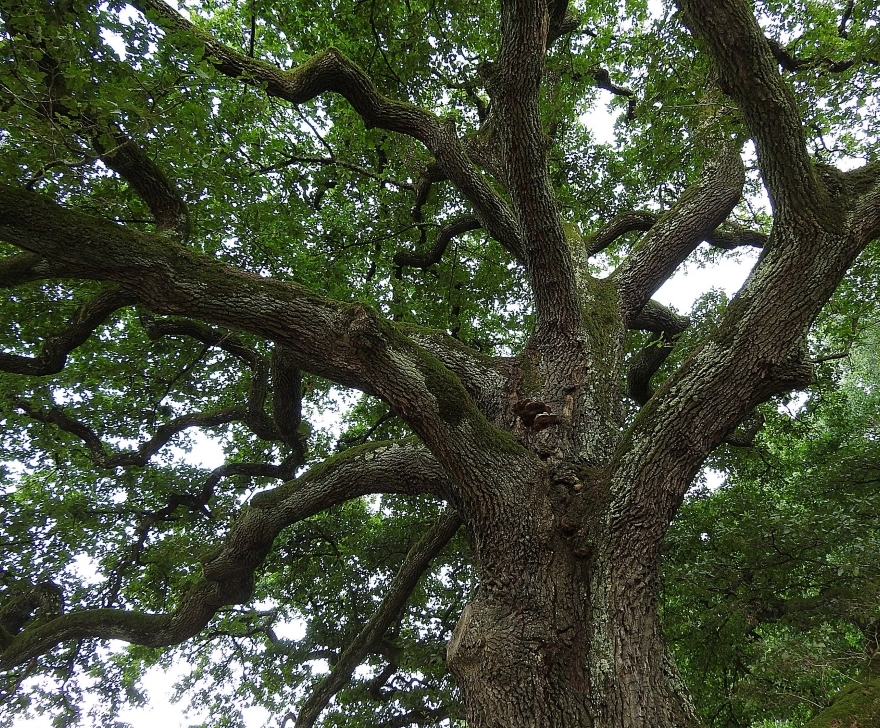
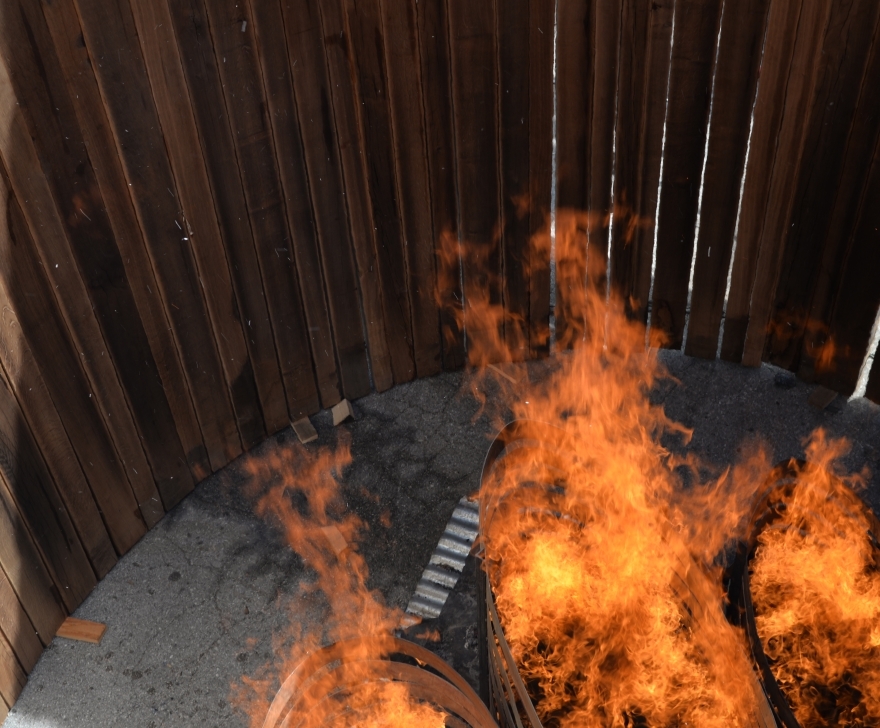
Criteria for the choice of trees: Healthy trunks, logging without any damages.
Age of the trunks: between 130 and 160 years (140 years on average).
Number of m³ of oak for the vat: At the start of processing, there were around 40-50 m³ of tree trunks; approx. 1/3 of this was actually used to build the vat (roughly 15 m³).
Drying time: Two-year storage period, only then is it possible to see what the wood can be used for. A piece of wood one centimetre thick needs around six months to dryThe term "dry" is used to describe the sweetness level of a ... More. Thus, if the wood is ten centimetres thick it takes at least 60 months (= five years).
Toasting time: Twelve hours steaming to bend the staves, twelve hours for toasting.
The bottom of the vat
A particular feature of the original 1,000-bucket vat was its ornately carved bottom, one of the biggest in central Europe. In 1953 the sculptor Sigrun Geppert (now Berger) was commissioned with its design. She created the motif “Noah receives the vine from the Lord God” within six months. The scene from Genesis (1st Book of Moses) showing how Noah receives a vine takes centre stage. According to the biblical story, Noah is the first person to plant a vineyard. The other carvings show parts of the winery, the towns of Rohrendorf, Krems and Dürnstein with the church and ruins as well as Noah’s Ark with animals and plants.
This unusual bottom of the vat is very well preserved and now adorns the front of the new 1,000-bucket vat. It thus brings the circle to full close with the 1,000-bucket vat that was previously in use for many decades.
The significance of the wooden vat
The new 1,000-bucket vat is a fascinating gem in the Lenz Moser winery. What’s more, wooden vats in general play an important role when it comes to wine ageing. The Lenz Moser winery can count the impressive number of 850 barriques as well as 17 large wooden vats. Lenz Moser has cultivated the tradition of barrique finishing since 1978, thus assuming a pioneering role in Austria. Over the past two decades, large wooden barrels have experienced a renaissance at Lenz Moser. Blauer ZweigeltDer blaue Zweigelt ist eine Kreuzung aus Blaufränkisch &... More and cuvée partners such as Cabernet Sauvignon and Merlot are left to age in the 4.000 to 11,000 litre vats.
What the winery manager Michael Rethaller appreciates about a wooden barrel is the natural aspect of winemaking – a natural product matures in a natural product. Finishing wine in wooden barrels calls for particular know-how, but intuition and experience are crucial for the quality of the wine that matures in these. This means that even in a large winery such as Lenz Moser, the emphasis is still on people. With wines that bear the signature of the cellar master.
Lenz Moser NOAH
The 1,000-bucket vat will be put to use as an ageing tun in the autumn of 2017. It will be filled with a cuvée of Blauer ZweigeltDer blaue Zweigelt ist eine Kreuzung aus Blaufränkisch &... More, Merlot and Cabernet Sauvignon from 2017.
The grapes will be harvested from the vineyards of the Castle winery of the Sovereign Order of the Knights of Malta in Mailberg. There Lenz Moser has been managing a 50-hectare vineyard area on lease since 1969; ten hectares of Blauer ZweigeltDer blaue Zweigelt ist eine Kreuzung aus Blaufränkisch &... More, five hectares of Merlot and five hectares of Cabernet Sauvignon. The planned maturing period for the “premiere wine” is at least twelve months.
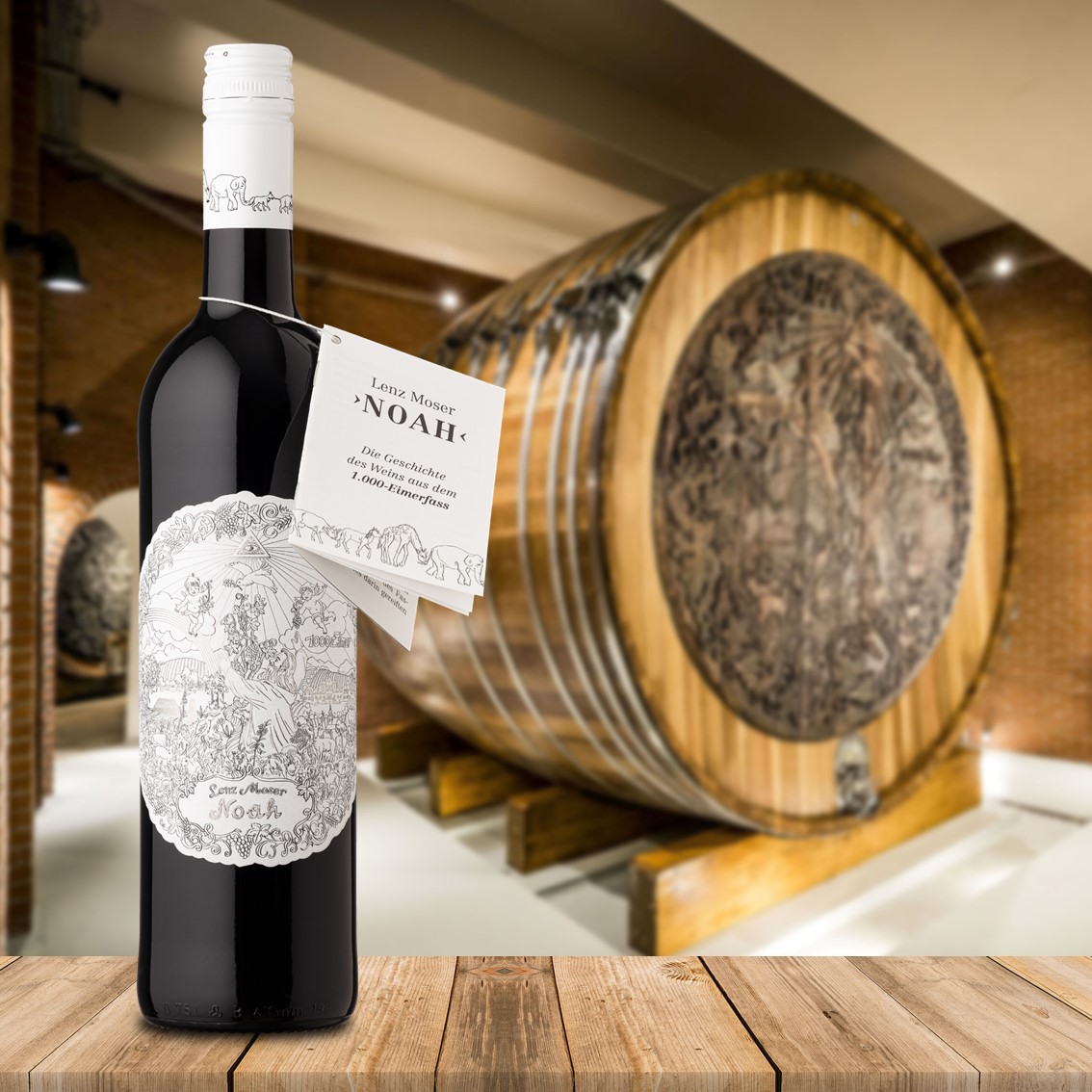
The construction of the 1.000-bucket vat
